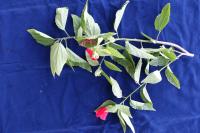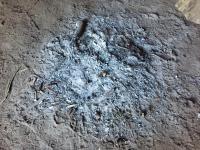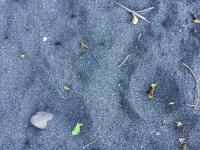nɨkaritig
listenloadingplaying
n.
kind of tree (Cerbera odollam) (with poisonous fruit with white sap inside tree and fruit)
Speaker: Martial Wahe
bookmark
nɨkatireu

listenloadingplaying
n.
type of flowering plant (collection: Michael J. Balick #5129)
Example: Ornamental plant.
Scientific name: Hibiscus rosa-sinensis, Speaker: Johnson Noar
bookmark
nɨkatireu

listenloadingplaying
n.
type of flowering plant (collection: Michael J. Balick #5138)
Example: Remove base from flower and chew flower--tastes sweet. Long ago there were no pens, you could use this flower to write message on wood.
Scientific name: Malvaviscus arboreus, Speaker: Johnson Noar
bookmark
nɨkava tapuga
listenloadingplaying
n.
kind of kava artificially sprouted at an upper node of a planted cutting (large tapuga are exchanged during circumcision feasts)
Speaker: Martial Wahe
bookmark
nɨkawahai-rea

listenloadingplaying
[nəkwa̤j reje]
n.
small tree, 4 m tall (collection: Gregory M. Plunkett #3132), used to make fishing spears, and used to make small house posts that support thatch roof
Example: Straight stem used for spear shaft
Scientific name: Tapeinosperma, Speaker: Jean Pascal Wahe, Martial Wahe
bookmark
nɨkinhapus
listenloadingplaying
n.
kind of tree (used for bows to hunt flying fox, and for traditional medicine), Goats like to eat the leaves.
Speaker: Martial Wahe
bookmark
nɨkɨrhanekin
listenloadingplaying
n.
traditional medicine, cure for illness caused by Mwatiktiki (culture hero responsible for yam growth)
Speaker: Martial Wahe
bookmark
nɨkoko

listenloadingplaying
n.
type of flowering plant (collection: Michael J. Balick #5077)
Example: Stem used to make canoe. Easy to cut.
Scientific name: Hernandia nymphaeifolia, Speaker: Johnson Noar
bookmark
nɨkriakéi
listenloadingplaying
n.
kind of tree, with edible green fruit with sweet milky white flesh, collected wild and eaten on Tanna
Speaker: Martial Wahe
bookmark
nɨkwesi

listenloadingplaying
n.
tree, growing in disturbed forest/garden area. (collection: Gregory M. Plunkett #3105)
Example: People eat the young leaves, boiling them in water until they are soft and ready to eat. Or, the green leaves are edible when raw, put coconut flesh and salt in the leaf and eat.
Scientific name: Ficus wassa, Speaker: Emmanuel Maasi
bookmark
nɨmarɨ

nɨmei raer

listenloadingplaying
n.
type of flowering plant (collection: Michael J. Balick #5088)
Example: Leaf used to thatch house. Chew base of stem as sugar cane - it’s sweet.
Scientific name: Miscanthus sinensis, Speaker: Johnson Noar
bookmark
nɨmeyev

n.
type of flowering plant (collection: Michael J. Balick #5060)
Example: Kastom medicine to ascertain the type of sickness a person has. Take two small 6 in. long branches with leaves, and place this on the person along with another unspecified plant. Will help diagnosis.
Scientific name: Breynia disticha, Speaker: Johnson Noar
bookmark
nɨmpen

listenloadingplaying
n.
type of flowering plant (collection: Michael J. Balick #5076)
Example: Leaves used in cooking to flavor soup. To cure sore known as "yaush" that is the size of a 50 vatu coin or larger, take 2-3 branches, collect leaves, put in pot, and warm. Wash the sore 3x day wash for 1-2 weeks. This disease is caused by flies and mosquitos. Yaush is the English name. Mosquito or fly bites the person, passes worm similar to filariasis, then a boil erupts and scratch it becomes big sore. Dry leaves and flowers, put in tin, and light it up to keep mosquitoes away. The smoke from this burning plant chases away mosquitoes like a coil.
Scientific name: Ocimum, Speaker: Johnson Noar
bookmark
nɨmrakw

nɨmramiri

listenloadingplaying
n.
type of flowering plant (collection: Michael J. Balick #5096)
Example: Fruits used to feed hens to increase fertility -- mix seed with dry coconut and give to hen to increase eggs.
Scientific name: Phyllanthus ciccoides, Speaker: Johnson Noar
bookmark

















